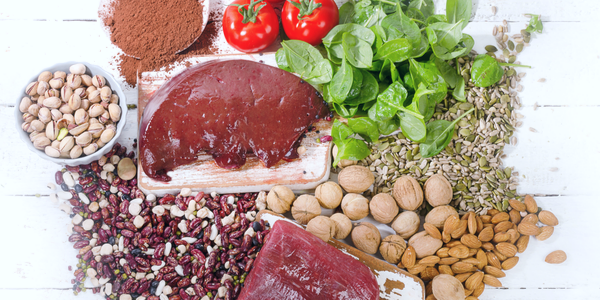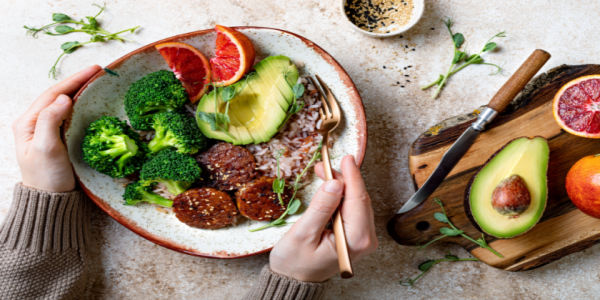
Iron is an important mineral that performs various functions within the body. Although a fair amount of foods contain iron, it is still one of, if not the most common nutrient deficiency in the world.
Discover why getting enough iron can mean the difference between easily walking up a flight of stairs or not being able to wake from bed. Also, learn how to maximize its effects in this complete guide about what iron does for the body.
What Is Iron?
Iron is a popular and vital mineral that the body uses for growth and development purposes. However, most iron benefits relate to oxygen.
Specifically, the body uses iron to make hemoglobin, a protein in red blood cells that helps carry oxygen from the lungs to the rest of the body. Iron benefits also include hormone development and myoglobin production where myoglobin is the protein that supplies muscles with oxygen.
Iron Classification
There are various ways to classify iron which has implications for its functionality.
First, there are two main forms of iron- heme and non-heme:
• Heme iron is only found in animal foods and is more absorbable at the cellular level.
• Nonheme iron is found in plant foods and is unfortunately not as readily absorbed.
In addition, when labs run iron panels, they typically test serum ferritin and transferrin in addition to serum iron. The body stores iron as ferritin in the liver, spleen, muscle, and bone marrow, so this value actually best reflects the body's true iron stores. Transferrin is the main iron transport protein and reflects how well iron binds to cells to be carried to other tissues. These different values have implications about different types of iron deficiency anemia and what symptoms can be expected.
Iron Intake Recommendations
Recommend Dietary Allowance (RDA) refers to the estimated amount of a nutrient per day necessary for proper health. Some nutrients only have adequate intake (AI) values, which simply means there is not enough evidence to establish an RDA.
Whereas some nutrient requirements remain stable throughout the lifespan, iron is one that changes frequently and depends on different states like pregnancy. The following table provides the RDA for different populations, denoted in milligrams (mg) per day.
Life Stage
Recommended Amount
Birth to 6 months
.27 mg
7-12 months
11 mg
1-3 years
7 mg
4-8 years
10 mg
9-13 years
8 mg
14-18 years
11 (boys) - 15 (girls) mg
Adult men ages 19-51 years
8 mg
Adult women ages 19-51 years
18 mg
Adults ages 51 years and older
8 mg
Pregnant teens
27 mg
Pregnant women
27 mg
Breastfeeding teens
10 mg
Breastfeeding women
9 mg
Daily iron intake depends mostly on age, sex, and pregnancy status but also depends on the type of diet one follows. As mentioned, nonheme iron in plant-based food sources is less absorbable. Thus, it is smart for vegans and vegetarians to add almost double the amount of grams onto each of these recommendations to ensure enough is being absorbed.
Because iron is involved in the growth and development of the brain and is lost through bleeding, other groups of people who may need additional iron include:
• Women with heavy periods
• Premature and low-birthweight infants
• Frequent blood donors
• Those with cancer, GI disorders like ulcerative colitis, and heart conditions/failure
To prevent toxicity of iron, the tolerable upper intake level is 40 mg a day for children and teens and 45 mg for adults. The tolerable upper intake refers to the maximum daily intake unlikely to cause harmful effects on health.
Acutely, not getting enough iron poses little harm and the body will simply utilize the iron stores from the muscles, liver, spleen, and bone marrow. However, chronically under-consuming or losing too much iron can cause stores to plummet, leading to iron deficiency.
Just like there are different classifications of iron, there are various ways to classify iron deficiency as well.
• Iron deficiency: low amount of stored iron (ferritin)
• Anemia: low hemoglobin levels
• Iron deficiency anemia: anemia specifically caused by low iron stores rather than anemia caused by low vitamin B12 or vitamin E
Iron deficiency occurs in stages and moves from mild to debilitating symptoms. The first stage is typically due to a diet low in iron or excessive bleeding that results in low ferritin stores. If left uncorrected, it morphs into mild deficiency and results in low transferrin levels and a reduction in red blood cells. In the final stage known as iron deficiency anemia, hemoglobin begins to drop, leading to fewer red blood cells that are smaller and contain less hemoglobin.
The first signs of iron deficiency are often tiredness and physical weakness since iron helps red blood cells carry oxygen throughout the body. As the iron deficiency progresses, it begins to affect nearly all bodily symptoms and includes symptoms such as:
• Lethargy and exhaustion
• Muscle and physical weakness
• Lack of focus and concentration
• Feeling cold and achey
• Pale/gray skin
• Hair loss and/or brittle nails
• Shortness of breath
• Dizziness or vertigo
• Swollen, sore tongue
• Abnormal heart rate
• Pica: cravings for non-food items like clay or laundry detergent
• Decreased ability to fight infections/illness
Iron Supplementation
Many people require supplementation to restore iron levels.
However, note that taking an iron supplement when it is not needed will do more harm than good. Young athletes sometimes take iron supplements assuming it will improve their oxygen capacity and athletic performance, only to realize the excess causes constipation and nausea if iron stores are already sufficient. Due to these main side effects, some people who actually require iron supplementation still do not replenish levels enough.
Trying to replenish iron stores through whole foods rich in iron is the first best route. But in cases where the supplemental form is necessary, it is important to know the difference between the different options.
Surprisingly, most regular multivitamins do not include iron, because toxicity is a risk and too much can cause constipation and nausea. So, simply taking a multi is not a good way to restore iron levels.
Instead, isolated, over-the-counter forms of iron exist and include ferrous sulfate, ferrous fumarate, and ferrous gluconate. In addition, some include a +2 or +3 at the end of the name or more than one number. For example, a ferrous sulfate iron supplement may indicate a total of 325 mg of ferrous sulfate on the front label but show 65 mg of elemental iron on the back label. Elemental iron refers to the amount that is actually absorbable by the body.
While all types of iron supplements will help restore levels if taken appropriately, some contain more absorbable forms and different release styles (like slow-release). For this reason, work with a doctor or dietitian who can guide the best supplement for your unique situation. It is rarely encouraged to supplement iron without guidance because of its toxicity risk, side effects, and supplementation confusion.
Iron-Rich Foods
As mentioned, there are heme and nonheme versions of iron. Heme is found in animal products and is better absorbed, especially alongside foods high in vitamin C.
Conversely, nonheme iron from plant foods is not readily absorbed because plants typically contain other nutrients like calcium, fiber, phytates, and tannins that reduce absorption, despite them being "healthy" nutrients.
Sources of heme iron:
• Beef
• Poultry
• Organ meats
• Oysters, clams, mussels
• Canned sardines
• Canned tuna
Sources of non-heme iron:
• Beans and lentils
• Fortified breakfast cereals, rice, and breads
• Spinach
• Potatoes with skin
• Nuts and seeds
• Dark chocolate
• Some fruits with iron include dates, figs, and prunes
To enhance the absorption of iron, eat vitamin C-rich foods like:
• Citrus fruits
• Bell peppers
• Sweet Potatoes
• Other fruits
• Orange juice
Another way to bolster iron levels is to cook with a cast-iron skillet. Some of the iron will leach into foods and increase the total available amount. Just be sure to clean it properly to avoid soap leaching into foods as well!
To prevent absorption problems, avoid foods high in calcium and/or vitamin D alongside iron-rich foods; namely, milk and other dairy products.
In Summary
Iron is a vital mineral that assists in the growth and development of the brain and mainly helps transport oxygen from the lungs to other tissues. Whereas heme iron in animal products is readily absorbed, nonheme iron in plants is poorly absorbed. For this reason, vegans and vegetarians should focus on eating vitamin C-rich foods alongside iron-rich foods. Using a cast-iron skillet when cooking can likewise be helpful.
Other populations that may need more than the RDA for iron include those who lose or donate a lot of blood. Runners are often also at risk, as iron is also lost by repetitive pounding. Iron deficiency is fairly common, so recognizing iron deficiency symptoms like fatigue, weakness, and rapid heart rate is important.
Nonetheless, it is wise to only seek supplementation with the assistance of a health professional!
References:
Andy the RD. The Three Stages of Iron Deficiency. Andy the RD. Published March 9, 2021. https://andytherd.com/2021/03/09/the-three-stages-of-iron-deficiency/.
Iron. The Nutrition Source. https://www.hsph.harvard.edu/nutritionsource/iron/.
Iron. NIH Office of Dietary Supplements. United States Department of Health and Human Services. Updated March 22, 2021. https://ods.od.nih.gov/factsheets/Iron-Consumer/.







